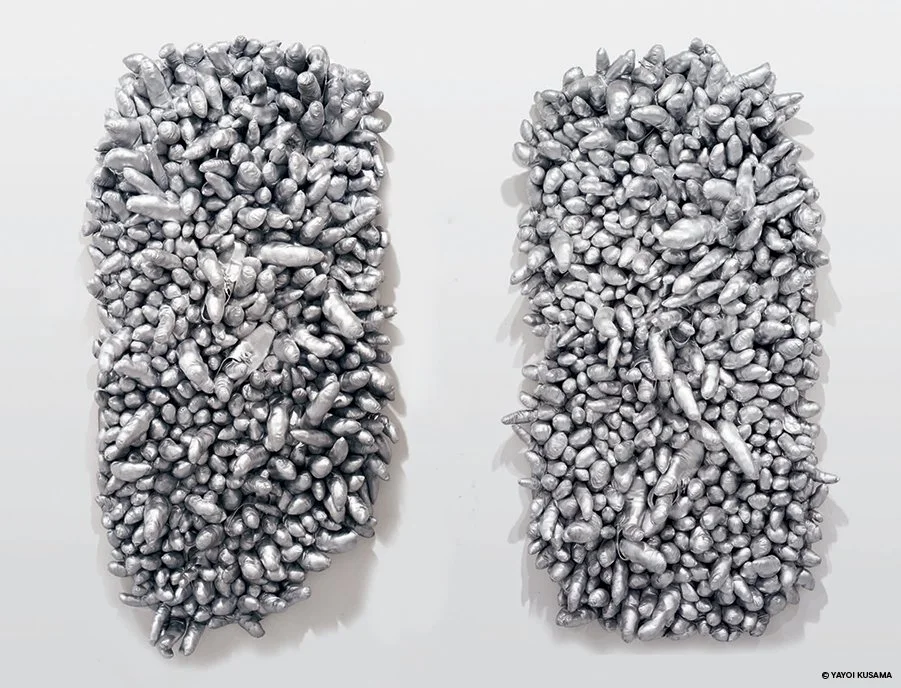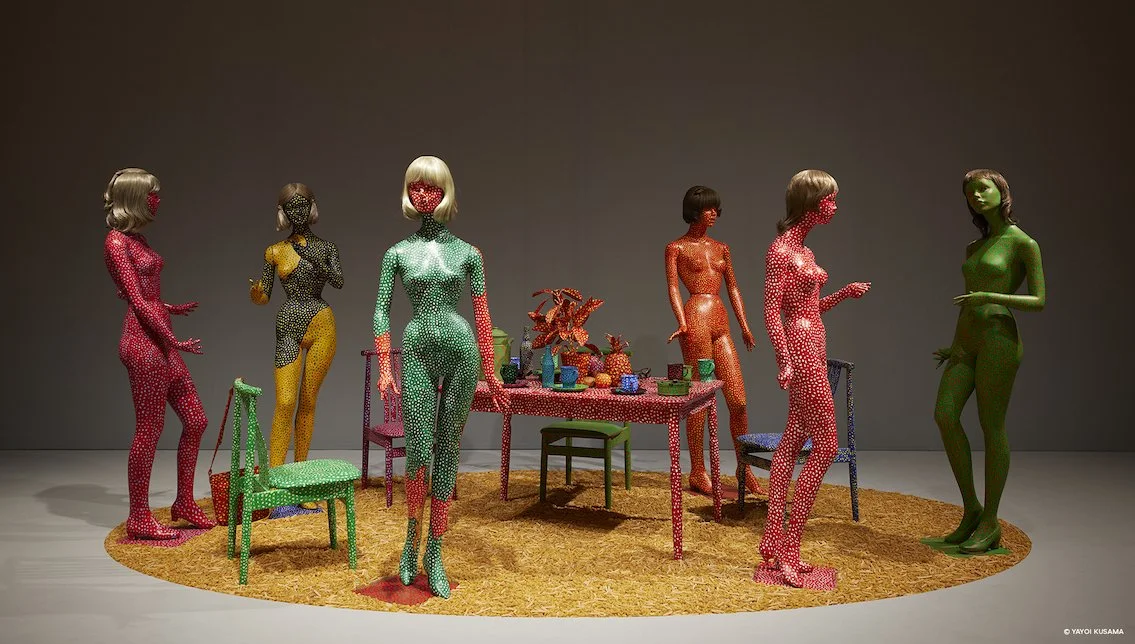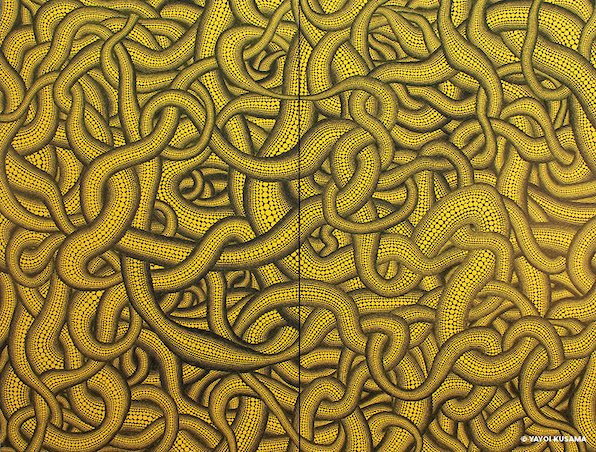Take-5: Yayoi Kusama
Arguably one of Japan’s most important 20th century artists, Yayoi Kusama gets a massive retrospective at M+. She’s way more than just polka dots.
There are probably plenty of people out there who never thought we’d get here, but lo! M+ is celebrating its first anniversary, and it’s doing so in pretty grand fashion. Most of us know the Matsumoto-born Yayoi Kusama for her bright, colourful, geometric canvasses and installations, essentially born when she directed a series of street performances involving a group of stark naked New Yorkers in the 1968 – stark naked except for polka dots. Kusama has acknowledged her difficult youth, her struggles with mental health and hallucinations, and how art was her anchor to some form of stability. Since her return to Japan in 1973 (when she checked herself into the psychiatric hospital she still lives in), her works have rolled feminism, obsession, anxiety, sex and sexuality, and trauma into an enormous body of abstract work that’s also stretched to fiction, film and fashion. Now 93, Kusama remains one of Japan’s most essential artistic voices, and entirely deserving of Yayoi Kusama: 1945 to Now, the largest Asian retrospective of her work outside Japan.
If Kusama’s archive and origins aren’t enough (the show includes over 200 pieces gathered from around the world, as well as Kusama’s own collection), the exhibition features three brand-new works: Death of Nerves, an installation commissioned by M+ as an extension of Infinity Nets (the first one dating to 1959); the immersive, kaleidoscopic Dots Obsession–Aspiring to Heaven’s Love, which showcases her signature polka dots and mirrored spaces; and two sculptures in the Main Hall, both titled Pumpkin, another Kusama motif. Yayoi Kusama: 1945 to Now runs through 14 May, 2023. Tickets are $240; $150 for students, children 7 to 11, seniors, persons with disabilities and companions, and CSSA recipients. Get more details from M+, www.mplus.org.hk. In the meantime, here’s a sample of some of Kusama’s most arresting work.
ENNUI (1976)
A soft sculpture companion piece to Untitled (Chair) from 1963 (also on display), Ennui features the same sewn, stuffed fabric and shoes she started experimenting with, and in many ways it’s every bit as menacing as the earlier work. Both confront Kusama’s self-described fears of and distaste for sex, and in Ennui there’s something just a little mouthy in the way she’s visualised the phallus. Pure defiance.
Self-Obliteration (1966-1974)
One of Kusama’s great installations. Painted in a repeating, boldly hued pattern Kusama calls an ‘infinity net’, the six trendy (in the ’60s) women are familiar in their gestures and alien in their appearance. The title refers to Kusama’s artistic process, one that sees her completely subsumed by her art. Here it may be a comment on the burgeoning feminist movement of the time, one that was starting to push back on the post-war obliteration of women’s identities.
Sex obsession (1992)
By the 1990s Kusama had matured in her imagery, and was less confrontational and on the nose in massaging her anxieties. Though let’s be honest: “less confrontational” is relative. The dotted, intertwining snake-like forms of Sex Obsession once again evoke male sexuality, but this time in the post-Greed is Good 1990s, a period of backlash against industrialised excess. The acrylic is a disturbing representation of the one being unable to separate from the whole, very nearly stating: “Yes, all men.”
Accumulation of Stardust (2001)
It’s easy to want to read meaning into Kusama’s work, but there’s something to be said for the simplicity of her lines and shapes, and the vividness of her colours. It’s easy to overlook just how rich and textured her images can be in her drive to interrogate sex, death and psychology. The three-dimensional quality to the dots on this trio of acrylic panels is mesmerising in how the depth of the red commands attention. Go ahead and read the subtext, but feel free to just bask in the aesthetics.
Pumpkin (2022)
Starting in 1946 with a traditional interpretation of the great gourd, pumpkins hold as significant a place in Kusama’s body of work as polka dots do. Her most famous pumpkin is perhaps her first permanent outdoor sculpture, Pumpkin, created for the Open Air ’94, ‘Out of Bounds’ contemporary exhibition in Naoshima. It’s at the end of the city’s pier now. Kusama has said she relates pumpkins to the few happy moments from her troubled childhood, their positive associations keeping her grounded.
Cedits: Yayoi Kusama | Ennui | 1976 | sewn stuffed fabric, paint, and shoes | two panels each: 183 ×98 ×23 cm | Takahashi Ryutaro Collection; Yayoi Kusama | Installation view of Self-Obliteration (1966-1974) at Yayoi Kusama: 1945 to Now, 2022 Photo: Lok Cheng | M+, Hong Kong ; Yayoi Kusama | Sex Obsession | 1992 | acrylic on canvas | two panels 194 ×260 cm | Lito and Kim Camacho Collection; Yayoi Kusama | Accumulation of Stardust | 2001 | acrylic on canvas | three panels 194 ×390 cm | Matsumoto City Museum of Art; Installation view of Pumpkin (2022) at Yayoi Kusama: 1945 to Now, 2022 | Photo: Lok Cheng | M+, Hong Kong.





